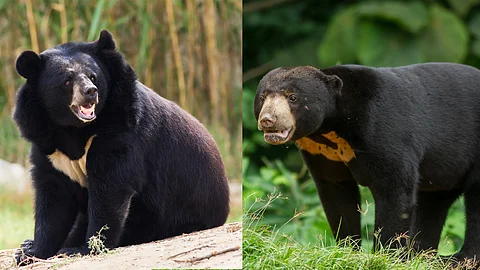

Even as Bangladesh is in the throes of a socio-political tumult in the wake of the recent ouster of its erstwhile leader Sheikh Hasina Wazed, researchers have some good news for wildlife lovers: two bear species are still extant in India’s eastern neighbour, as per their research.
The Asiatic black bear (Ursus thibetanus) and the Malayan sun bear (Helarctos malayanus) are both present in Bangladesh, the researchers confirm in their study.
This is significant as the distribution of bears in the country is ‘unclear’ as per the International Union for Conservation (IUCN) of Nature Red List. Black bears are described as ‘scattered’ and ‘likely to be very low in number’ and sun bears as ‘vagrants’ entering from the adjoining north-east Indian forests.
However, the researchers found otherwise in their study.
The experts compiled recent evidence of bear presence in Bangladesh based on camera trapping, literature reviews and analysis of media reports.
They were able to trace 43 verifiable accounts of black bears in the country from peer-reviewed and grey literature published during 2010-2022.
“Our camera-trap survey in Rajkandi Reserve Forest produced the first ever evidence of a small population of black bears in north-eastern Bangladesh. Two field studies (in 2016 and 2021) reported camera-trap observations and multiple incidents of poaching of sun bears in Kassalong Reserve Forest and Sangu-Matamuhuri Reserve Forest in south-eastern Bangladesh,” they noted in their paper.
Moreover, an analysis of media reports showed that 80 people had been injured and three had died due to bear attacks, while 13 bear casualties (six dead, seven rescued) had been reported during 2003-2023.
Incidents of human-bear conflict peaked in the summer (17); 79 per cent were reported during 2018-2023.
The researchers found no evidence of sloth bears (Melursus ursinus) in Bangladesh. The species was assessed as ‘locally extirpated’ in the IUCN’s most recent regional assessment
The extirpation has been linked to the disappearance of the wet deciduous forests of northern and central Bangladesh that were rich in termite mounds and formed the primary habitat of this ‘myrmecophagous’ (termite or ant eater) species in the country.
The researchers noted that while two bear species are extant in Bangladesh, their study calls for systematic conservation measures for both in the unprotected hill forests of the country’s east, cognizant of the fact that the absence of evidence is not evidence of absence.
The main threat facing bears is conflict with humans. According to the researchers, eastern Bangladesh appears to be an area of frequent human-bear conflict, based on their analysis of media reports.
“During 2007-2010, 47 bears were reportedly killed in this region. The reported incidents mostly took place in summer, the harvesting season of fruits and crops,” the study noted.
Worryingly, the number of conflict incidents during 2018-2023 (23) in Bangladesh was higher than in Bhutan and Pakistan.
While a compensation policy has been legislated under Clause 52 of the Bangladesh Wildlife (Security and Protection) Act 2012 if human-bear conflict occurs, there have been no studies or initiatives to systematically address the patterns and drivers of human-bear conflict incidents within Bangladesh.
This is in contrast to tigers which are found in the Bangladeshi section of the Sundarbans, where such activities have been conducted.
Another threat to bears is the illegal trade in live bears and bear parts as well as poaching.
“This study emphasizes the hitherto unnoticed wildlife trade and poaching activities that target bears. This is a threat as demand for live bears (for use in menageries and circuses), bear trophies and bear derivatives (bear bile, claws, etc.) is high. Both bear species are protected under Schedule I of the Bangladesh Wildlife (Security and Protection) Act 2012, however, Asiatic black bears are kept in various private and government zoos across the country, with the origin of these bears remaining undocumented,” the paper read.
The researchers wrote that efforts to conserve bears in Bangladesh are far below the investments made to preserve the tiger in the Sundarbans.
They added that bear research in the country suffers from a lack of research infrastructure and collaboration, inadequate funding and awareness-raising programmes, logistical difficulties and a lack of knowledge regarding the conservation of less charismatic wildlife amongst policymakers.
They made a number of recommendations for strengthening bear conservation efforts in the country.
Its government should involve members of the IUCN Species Survival Commission Bear Specialist Group in Bangladesh and the Asian Bear Monitoring Expert Team in future monitoring efforts.
The study showed the Sangu-Matamuhuri Reserve Forest and Kassalong Reserve Forest to be the last strongholds of bears in Bangladesh. Hence, they could be elevated to flagship species for the conservation of the mammalian communities living there, the researchers suggested.
The experts recommended systematic monitoring of bears in eastern Bangladesh using advanced camera trapping and genetic methods; government-level support, encouragement and endorsement of bear research and conservation initiatives in these locations; the preparation of comprehensive human–bear conflict mitigation guidelines, implementation plans and rapid response teams; systematic documentation of human-bear conflict casualties at district hospitals in eastern Bangladesh and a centralised repository of these data at the Bangladesh Forest Department.
Stringent measures should be taken to protect the forest habitats in eastern Bangladesh and reduce poaching, they added.
Assessing the conservation status of and challenges facing Asiatic black bears and Malayan sun bears in Bangladesh on December 2, 2024.